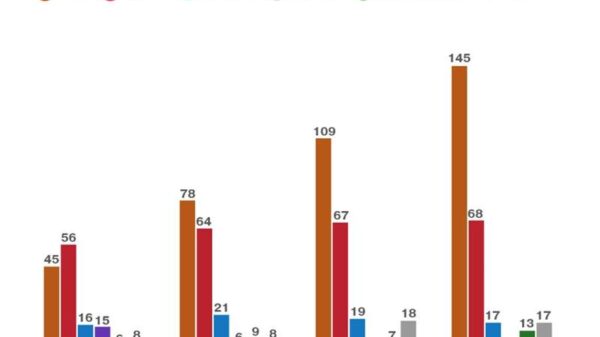Dennis Duncan’s entertaining and informative “Index, A History of the” moves from the 13th-century origins of the form to the world of digital search engines.
INDEX, A HISTORY OF THE
A Bookish Adventure From Medieval Manuscripts to the Digital Age
By Dennis Duncan
Illustrated. 344 pages. W.W. Norton & Company. $30.
Before reading “Index, A History of the,” an appealingly titled new book by Dennis Duncan, I had never thought of the index as much more than a tool — a handy list of subjects and proper names, typically at the end of a nonfiction book, guiding me to the page(s) where I might find the information I seek.
There are of course some indexes that make you want to linger; a reader of Martin Amis’s memoir, “Experience,” will find a strikingly long list of curious items nested under “dental problems” (“of animals,” “Bellow on,” “and dentifrice purchase,” etc., etc.). But, Duncan says, we usually turn to an index as a “convenience” and “timesaver.” It’s like a map. In fact, it is a map — an indicator of a spatial relationship. It points (like an index finger) to a place (a page number), showing you the way.
If all of this sounds obvious and unobjectionable, Duncan’s smart, playful book will encourage you to think again. The straightforward utility of the index turns out to be what made it such a disruptive innovation in the first place. “A history of the index is really a story about time and knowledge and the relationship between the two,” Duncan writes, with an admirable clarity that also hints at the enormousness of his subject. “Today, the index organizes our lives.” The morass of the digital world is indexed and served up to us by search engines.
This book is, on one level, a history of information science, but it’s also a history of reading and writing and everything those actions entail — communication, learning and imagination, as well as competition, anxiety and no small amount of mischief.
With the advent of the printing press, the proliferation of indexes generated the scornful epithet “index-raker,” directed at the writer who larded his work with gratuitous quotations, plucked from books whose indexes he consulted but whose actual texts he hadn’t read. The moral panic sounds exorbitant in retrospect, but as Duncan wryly points out (so to speak), none of it is entirely unfamiliar. “The book index: killing off experimental curiosity since the 17th century.”
Like so many technologies we now take for granted, the index was slow to become embedded so seamlessly in our lives. Duncan gives a surprisingly vivid explanation of how the two foundations of the contemporary index — alphabetical order and pagination — themselves had to be invented. Alphabetical order requires us to pay attention not to meaning but to spelling, ensuring it would stay rare through the Middle Ages, disdained as an arbitrary imposition that was “the antithesis of reason.” As for numbering pages, the notion of something so “ruthlessly disinterested” from the text — impertinently insisting on a number for every page, regardless of its tendency to cleave paragraphs, sentences, even words — made it an intrusion that took some getting used to; the number’s allegiance wasn’t to the argument or the story but to the physical book itself.
Duncan locates the origins of the index in the 13th century, when the English polymath Robert Grosseteste — poet, lecturer, preacher, statesman — created his “Tabula,” so that he could efficiently access the many sources for his vast store of knowledge. The “Tabula” was ordered conceptually, broken down into 440 topics, starting with God. It was a device born of necessity, bringing “cosmos out of chaos,” Duncan writes. “An encyclopedic mind needs an encyclopedic index to provide it with structure.”
Early indexes often contained a paragraph of explanation for the medieval reader unfamiliar with how they worked, suggesting that their use was anything but intuitive. But eventually the index became common enough that clever writers began to play with its terse form. Its brevity made it an excellent vehicle for wit — a barb for puncturing bloated egos and windbag grandiosity.
Duncan gives us several feuds that involved a weaponized index. One sterling example from the late 17th century was a pamphlet lampooning a rival scholar with an index telling readers where they might learn more about “His egregious dullness,” “His Pedantry,” “His collection of Asinine Proverbs.” Another example was wilier — a professional indexer slipped some of his own Whig sympathies into the back of a book written by a staunch Tory, including a subtly worded reference to a wild Whig conspiracy theory involving a baby and a warming pan.
That Duncan brings these old, intricate disputes to life is a testament to his gifts as a writer — imaginative but also disciplined, elucidating dense, scholarly concepts with a light touch. He also includes examples of fictional indexes in order to draw attention to the form’s peculiarities. (Duncan’s previous books include one about the Oulipo, the avant-garde group whose writers experimented with constraints, including indexes.) In J.G. Ballard’s story “The Index,” the last entry, beginning with Z, is necessarily the end of the narrative; the same goes for the index that provides the last line to Nabokov’s novel “Pale Fire” — “Zembla, a distant northern land.”
But part of what makes an index so useful is that its sequence isn’t aligned with the structure of the work it refers to at all. This incongruence, a splitting apart of content and form, is part of what used to cause so much hand-wringing: Would readers of an intimidatingly big book decide only to skim the simulacrum — the bite-size summary offered by the index — instead of immersing themselves in the real thing?
Duncan finds analogous anxieties in our Age of Search — the suspicion that by making it ever easier to access information, Google might in fact be making us lazier and dumber, allowing us to glide along the shallows instead of forcing us to venture into the depths. Duncan is less worried. “It is good for the nerves, I think, to have some historical perspective,” he writes. But he allows that our infatuation with digital search has perhaps endangered something else — the art of the index, which has traditionally borne the imprint of the human being who compiles it.
“Index, A History of the” is furnished not with one index but two. The first, which is partial, was created by commercial indexing software that spat out a “squall of entries,” including useless ones for “alas” and “all the letters.” The second was compiled by Paula Clarke Bain, a professional indexer. I don’t want to give anything away (words I never thought I’d use about an index), other than to say that its relationship to Duncan’s text is not just as a guide but also as a companion. Duncan has written such a generous book, attentive to the varieties of the reading experience, that it’s only fitting he gave Bain’s index some space to flourish, a chance to come into its own.



























